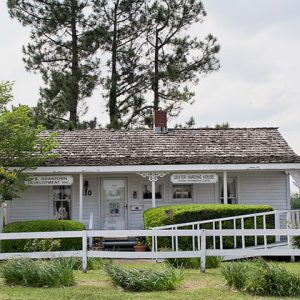calsfoundation@cals.org
Dexter Harding (1796–1862)
Dexter Harding was one of the early citizens of Pine Bluff (Jefferson County) and owned the first sawmill in town, providing lumber for the homes and businesses from 1850 to 1860. In the 1980s, his pioneer home was converted to a tourist bureau because it was the oldest house in town. He was a brother to Chester Harding, a well-known artist who painted a picture of Daniel Webster and the only painting done from life of Daniel Boone.
Dexter Harding was born on July 8, 1796, in Massachusetts. He was the sixth of fourteen children born to Abiel Harding and Olive Smith Harding. When he was ten years old, the family moved to Madison County, New York. They grew up poor. His father was an aspiring inventor whose inventions were not successful. The children helped their mother with chores and farming. Their mother often read to them from the Bible, the only book in the home.
During the War of 1812, when Harding was sixteen, he joined the U.S. Army in the Regiment of Volunteers of New York as a drummer boy on May 18, 1812, and served until May 18, 1813. After his discharge, Harding helped his father make musical instruments for the army until the war was over. Then, he followed his brother Chester to Hopkinsville, Kentucky, where he met Jane Allen. They were married on October 18, 1821, and had thirteen children. He operated the gristmill for Chester.
Dexter Harding and wife traveled to Pine Bluff during the early part of 1850. Congress had passed a law on September 28, 1850, which enabled Dexter to be eligible for a War of 1812 land grant. He acquired 160-acre tract of land in southeast of Pine Bluff. Harding later became the master of the Masonic lodge of Pine Bluff and put the original grant of land in the cornerstone of the building.
Harding built the first sawmill in town, as well as a three-room house made out of timber for his family. There were hand-hewn logs for sills and dowelled studs, fitted without the use of nails. The lake on his property was named after Harding. All that is left of Harding Lake now is the Harding Drain, located near the Pine Bluff Convention Center. The sawdust accumulated in the Harding Lake for a few years. A bridge was formed across the north bank to the south bank, which was the only way to travel to Pine Bluff from the south. The people dreaded crossing its moving, creeping surface, especially at night because of the strange lights, weird noises, snakes, and alligators. The bridge was abandoned when Main Street was opened. In 1976, the Bicentennial Commission installed an historical marker about the Sawdust Bridge on State Street near the original location on south side of the Pine Bluff Civic Center.
During the Civil War, Harding converted his sawmill into a gristmill that provided meal and flour for the Confederate army and the local residents. Union troops destroyed the bolting cloth (used for sifting) during one of their raids. Two of Harding’s daughters, Mary and Susan, and their cousin, Molly Tisdale, cut up their tarlatan (a stiff, thin, transparent muslin) and used it as bolting cloths, enabling the mill to grind the corn meal. The girls’ scheme helped to save the town by providing meal and flour for them.
Dexter Harding died on May 7, 1862, in Pine Bluff and was buried in Bellwood Cemetery. Harding Avenue was named after him. His house stood at 1109 Texas Street until 1968, upon the death of Blanche F. Edgar, the last Harding heir to live on the property. The original three rooms of the thirteen-room structure were marked, dismantled, and stored. In 1973, the Urban Renewal Agency purchased the property, and the Pine Bluff Convention Center and Civic Center were built there. In 1975, the Jefferson County History Commission Committee raised funds to match a grant from Arkansas Bicentennial Celebration Commission to erect the original materials from the Harding house on a city-owned lot across the street from the Jefferson County Courthouse on Pine Street. This dwelling was chosen because it was the oldest house in town. The Dexter Harding Tourist Information Center opened on July 8, 1985. A portrait of Dexter Harding, painted by his famous brother artist, Chester Harding, was hung over the fireplace in the entrance room.
For additional information:
Tomlinson, Mary Roane. “The Dexter Harding Family.” Arkansas Democrat Sunday Magazine, April 22, 1951, pp. 4, 13.
———. “Sawdust Bridge.” Arkansas Democrat Sunday Magazine, September 10, 1950, p. 1.
Brenda J. Hall
White Hall, Arkansas
 Business, Commerce, and Industry
Business, Commerce, and Industry Politics and Government
Politics and Government War of 1812
War of 1812 Dexter Harding
Dexter Harding  Dexter Harding
Dexter Harding  Dexter Harding's Tombstone
Dexter Harding's Tombstone  Dexter Harding House
Dexter Harding House  Sawdust Bridge Sign
Sawdust Bridge Sign 



I am doing some Ancestry work and discovered Dexter Harding is my great-great-grandfather.
Where are the portraits that hung in the Harding house now (fall 2023)? I am a blood relative of Dexter Harding and understand that the portraits are no longer in the house.